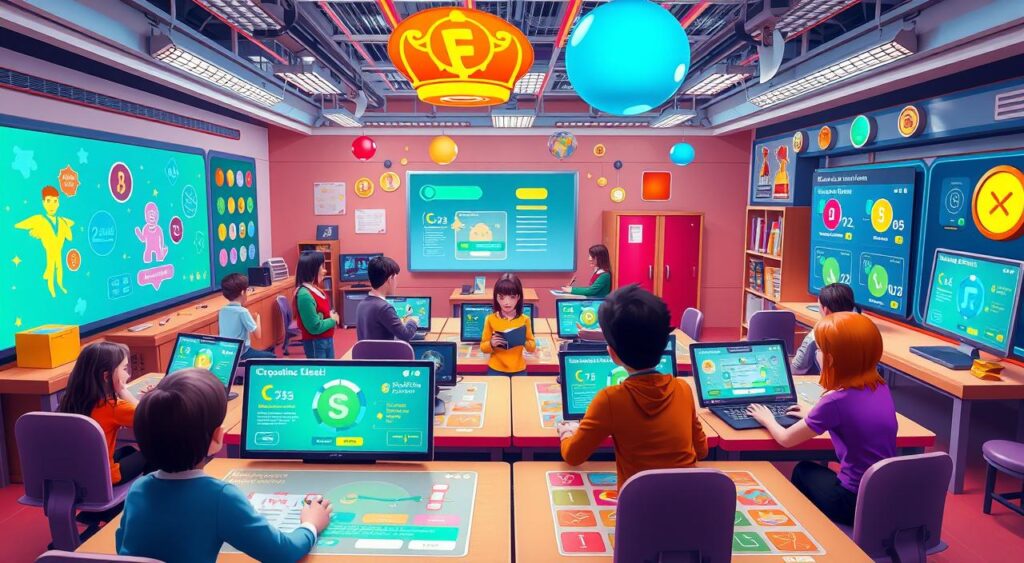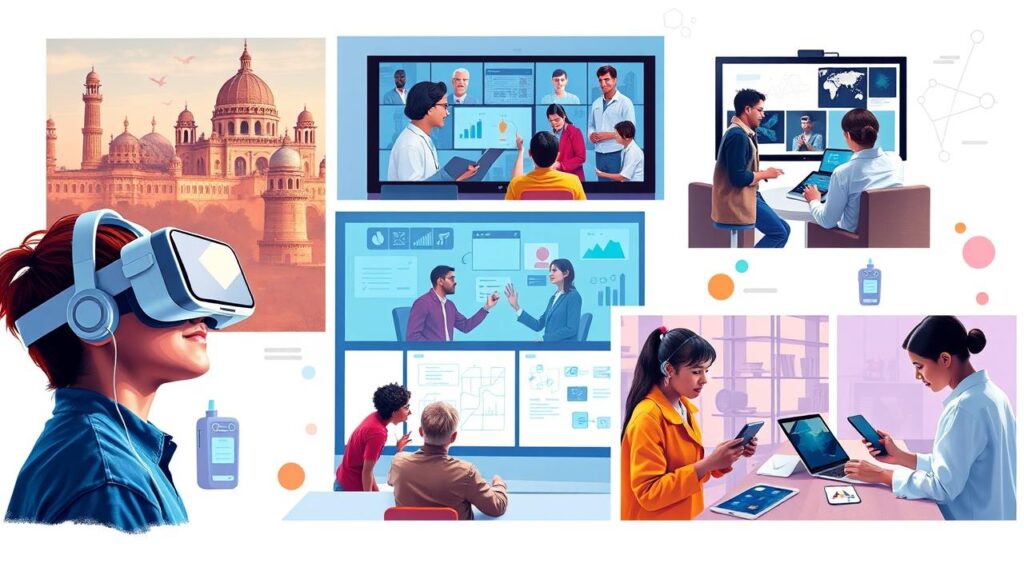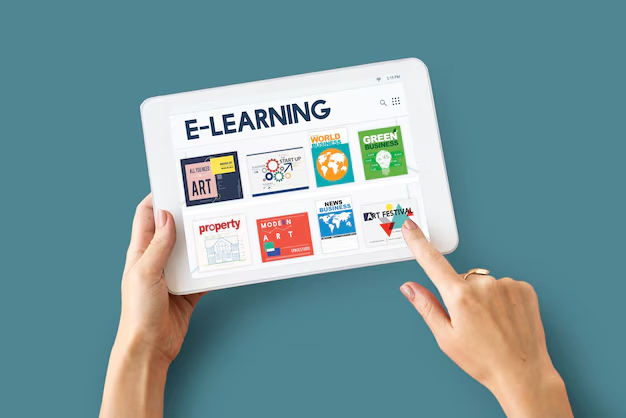Are you new to digital learning or have some experience? Digital learning environments offer both chances and challenges. This article will show you how to excel in digital learning settings. You’ll learn about boosting student engagement, promoting collaborative learning, and using real-world applications.
By grasping the essential principles of digital learning, you can change your learning journey. You’ll become a better student or teacher in the digital world.
Key Takeaways
- The average number of educational technology (edtech) tools accessed per school district in the USA has increased significantly, indicating a growing reliance on digital resources for teaching and learning.
- Over 50% of K-12 students engage with educational games as part of their e-learning resources, highlighting the integration of innovative teaching strategies like microlearning and gamification in digital learning environments.
- A majority of K-12 teachers express a desire for more educational technology (edtech) to support students’ individualized learning plans, emphasizing the importance of personalized learning experiences facilitated by digital platforms.
- Digital learning equips students with the skills and competencies necessary to succeed in future digital workplaces, fostering technological literacy and a mindset of lifelong learning.
- Culturally responsive teaching can enhance student engagement and success by incorporating students’ cultural references in all aspects of learning, especially for Hispanic students who often come from diverse backgrounds.
Understanding Student Engagement in Digital Learning
Student engagement is key in digital learning. It’s about the effort and interest students put into their studies. As a teacher, you aim to boost their academic success and spark a love for learning.
What is Student Engagement?
Student engagement in digital learning has three main parts: cognition, behavior, and affect. Cognition is about thinking and solving problems. Behavior is about participating in class. Affect is about feeling connected to the material and enjoying the course.
Strategies for Cultivating Student Engagement
To boost student engagement, teachers can try several methods. These include:
- Using group work to foster teamwork and learning from peers
- Adding fun elements to lessons to make them more engaging
- Linking lessons to real-life situations that interest students
- Using tech tools to tailor learning to each student’s pace
By focusing on engagement, teachers help students succeed in digital learning. They also inspire a lifelong passion for learning.
| Engagement Strategy | Benefits |
|---|---|
| Collaborative Learning | Encourages teamwork, communication, and critical thinking skills |
| Gamification | Increases motivation, engagement, and content retention |
| Real-World Applications | Helps students connect course material to their personal and professional interests |
| Leveraging Technology | Enables personalized learning experiences and access to a wider range of educational resources |
“Engagement is the holy grail of learning, and when students are engaged, they learn and achieve more.” – Bill Daggett, Founder of the International Center for Leadership in Education
Fostering Collaborative Learning in Digital Environments

The digital age has changed how we learn, offering new chances for collaborative learning. Educators use digital tools and strategies to make learning fun and interactive. This helps students improve communication, problem-solving, and critical thinking.
Benefits of Collaborative Learning
Learning together online has many benefits:
- Students get better at communication by talking and sharing ideas with peers
- They learn to think critically and solve problems together
- They also gain from each other’s experiences, enhancing social learning
Tools for Facilitating Online Collaboration
To support collaborative learning online, educators use various digital tools. These include:
- Discussion groups and virtual classrooms for live chats and discussions
- Learning management systems (LMS) with tools for group work and projects
- Collaborative document editors like Google Docs for team work on documents
- Presentation and multimedia tools for group projects and presentations
Using these digital tools, educators can make learning more engaging. This helps students work together, share ideas, and develop important skills for today’s world.
Digital learning: Gamifying Lesson Plans

Gamifying lesson plans boosts student engagement and excitement in digital learning. It adds game-like elements like digital trivia and leaderboards. This makes learning fun and interactive.
It taps into students’ love for play and competition. This makes complex topics easier and more enjoyable. Gamification turns traditional lessons into engaging, interactive experiences.
Research shows gamification improves learning significantly. Students using gamified tools show quick progress. A Spanish study found digital learning games boost learning outcomes.
“The impact of gamification on learning is substantial, with performance improvements within one month equivalent to more than a year of progress with traditional teaching methods,” says Dr. Fraga Varela, a researcher.
Gamification boosts engagement and motivation. It also helps develop teamwork and a growth mindset. It encourages students to celebrate each other’s successes.
By adding game-like elements, educators can create engaging learning experiences. These experiences foster engagement, creativity, and competition. With the right tools, teachers can use innovative strategies for personalized learning.
Incorporating Real-World Applications in Digital Learning

One big challenge in digital learning is making course materials relevant to students’ lives. By adding real-world applications to lesson plans, teachers help students see the connection between learning and their future. This makes learning more meaningful and exciting.
Students learn best when they solve real problems, study case studies, and work on projects. These activities improve critical thinking skills and show the practical value of what they’re learning. When students see how their studies relate to in-demand career skills, they become more interested in the material.
Why Real-World Examples are Crucial
Real-world examples make digital learning more relatable and relevant. This approach boosts student engagement and prepares them for success. Personalized learning and hands-on experiences that connect to the real world sharpen problem-solving and critical thinking skills. These skills are essential for future careers.
Approaches to Integrating Real-World Scenarios
- Use case studies to show how course concepts are used in different industries or real-life situations.
- Offer project-based learning where students solve authentic problems and present their solutions.
- Provide simulations and virtual environments for hands-on, immersive learning experiences that mimic real-world scenarios.
- Work with local businesses or organizations to create internships or apprenticeships for valuable on-the-job experience.
By adding real-world applications to digital learning, teachers make their courses more relevant. This approach develops career skills and prepares students for the modern workforce.
Leveraging Technology in the Digital Classroom

The use of digital tools is key in today’s digital learning spaces. Teachers can use many multimedia and interactive tools. This helps create fun, deep learning experiences for all students.
Using Multimedia and Interactive Tools
Video and audio lessons, discussion forums, and online group work are just a few tools available. Learning management systems help teachers share content and support students in real-time or at their own pace. They also make learning more accessible for everyone.
Adapting to Students’ Digital Literacy
Teachers must adjust their methods to meet students’ different tech skills. Giving clear directions, tech help, and flexible learning paths ensures all students can succeed. This makes the digital classroom inclusive for everyone.
Also Read: How To Choose The Best E-learning Tools For Your Online Courses
Using technology in education can change the game. It helps students achieve more in their digital learning adventures.
“Education technology has become one of the fastest-growing global industries.”
Conclusion
Digital learning environments are changing fast, offering both challenges and opportunities. Understanding how to engage students, work together, and use technology can make a big difference. This can unlock the full power of digital education.
Whether you’re a student or an educator, there are strategies to help you thrive in digital learning. By embracing digital learning, you can grow to love learning more. You can also develop important skills for the 21st century and change education for the better.
Research shows mixed results on digital learning versus traditional teaching. But, it’s clear that keeping students engaged is key. By encouraging active participation and teamwork, educators can make digital learning exciting and effective. This leads to happier students and better learning results.
FAQs
Q: What are the benefits of using a virtual learning lab in digital learning environments?
A: A virtual learning lab provides a flexible space where learners can engage with digital content and collaborate on projects, facilitating active learning and enhancing their understanding of course material through hands-on experiences.
Q: How can instructional design impact student success in online learning?
A: Effective instructional design is crucial as it shapes the learning experience. By employing sound learning strategies and creating engaging course content, instructors can ensure that students are effectively supported and motivated to learn in digital learning platforms.
Q: What should I consider when choosing a learning platform for my course in 2024?
A: When selecting a learning platform, consider factors such as accessibility, user-friendliness, the ability to support immersive learning experiences, and the range of digital learning tools available to enhance your course design.
Q: How can immersive learning enhance the learner’s experience in online courses?
A: Immersive learning allows students to engage deeply with course content through interactive experiences, such as virtual field trips and simulations, which can significantly elevate their understanding and retention of material.
Q: What role does digital learning design play in higher education?
A: Digital learning design is essential in higher education as it provides a framework for creating high-quality online learning experiences. It ensures that courses are well-structured, engaging, and aligned with learning outcomes, ultimately supporting learner success.
Q: How can instructors support learning in a digital learning initiative?
A: Instructors can support learning by utilizing effective digital learning tools, fostering collaboration among students, and providing timely feedback. This approach helps maintain engagement and ensures that learners feel supported throughout their educational journey.
Q: What are some key learning strategies to implement in course design for online learning?
A: Key learning strategies include incorporating active learning techniques, using diverse assessment methods, providing opportunities for peer collaboration, and ensuring that course content is relevant and accessible to all students.
Q: How can digital learning platforms facilitate collaboration among students?
A: Digital learning platforms often include features such as discussion forums, group project tools, and real-time communication options, allowing students to collaborate easily and share ideas, thereby enhancing their learning experience.
Q: What tools can help instructors create engaging digital learning environments?
A: Instructors can utilize various tools like multimedia content, interactive quizzes, and gamification elements to create engaging digital learning environments that capture learners’ interest and encourage participation.
Source Links
- https://education.illinois.edu/about/news-events/news/article/2024/04/04/what-is-digital-learning-and-why-should-you-get-a-certificate
- https://wcet.wiche.edu/frontiers/2024/07/19/nurturing-success-fostering-a-caring-digital-learning-environment-at-hsis/
- https://www.everylearnereverywhere.org/service/developing-a-digital-learning-ecosystem-to-ensure-student-success/
